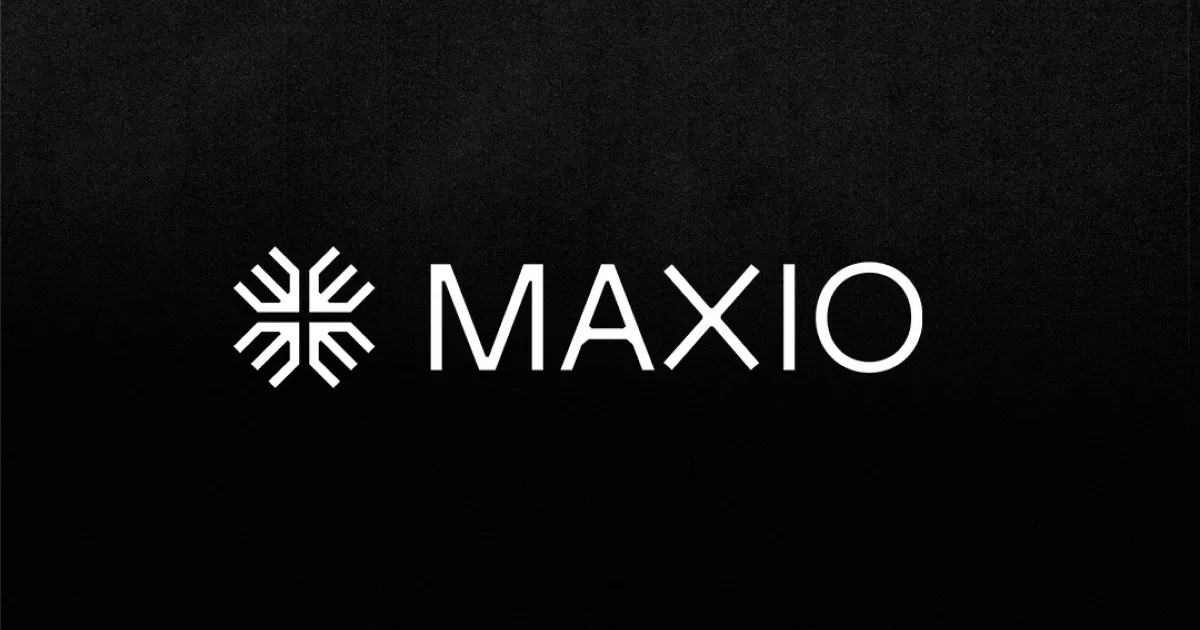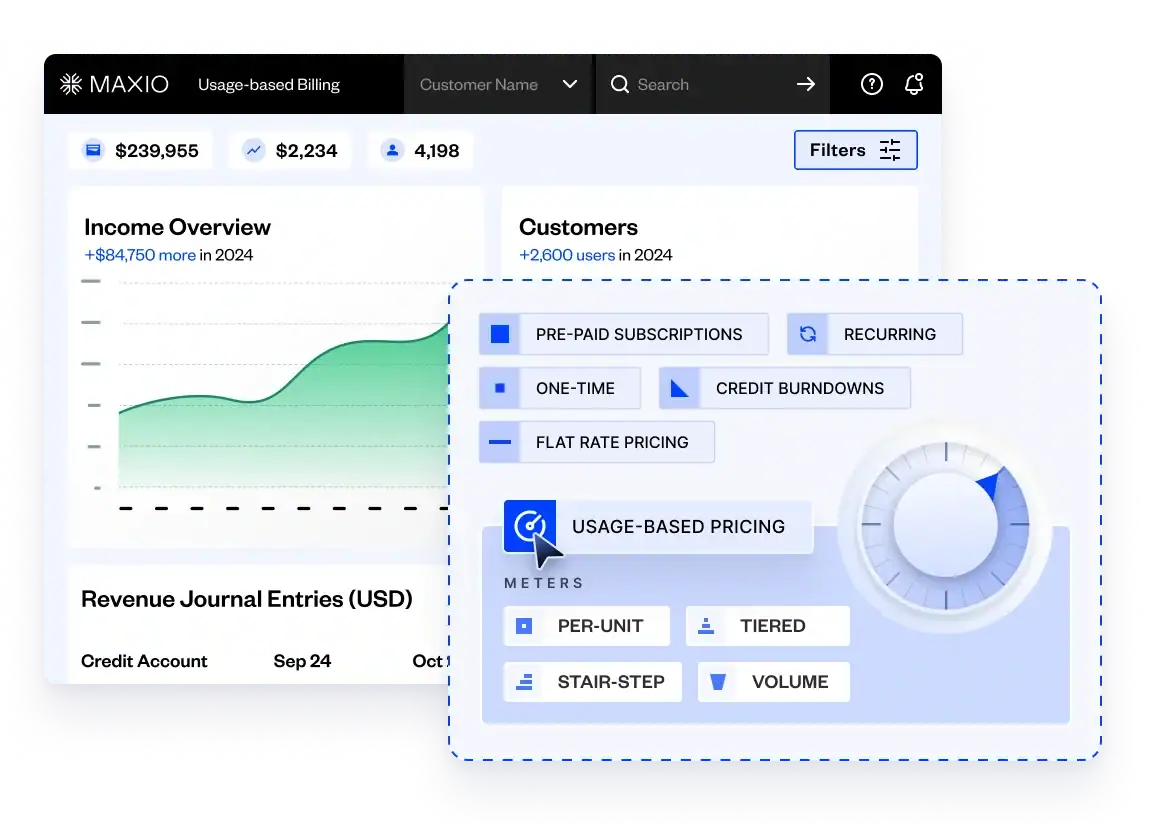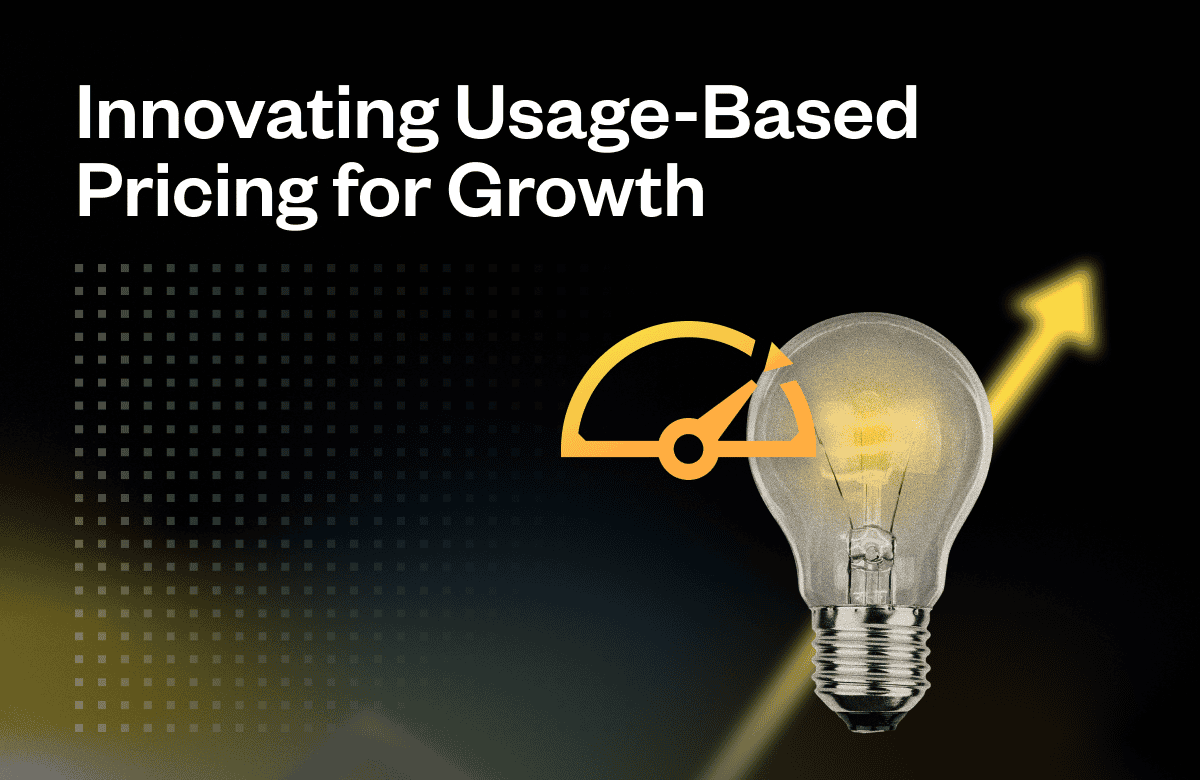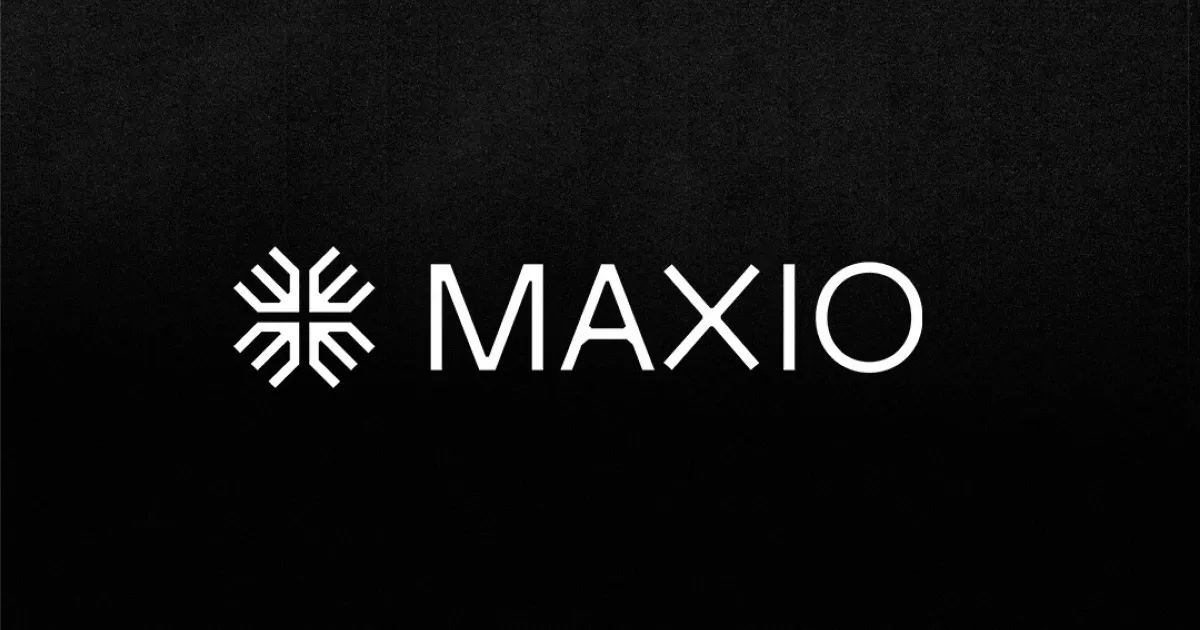Increasingly agile and scalable server environments have revolutionized the SaaS industry from top to bottom.
Even when it comes to pricing and billing, SaaS companies can no longer afford to remain static — offering a few fixed-price options that only appeal to a limited number of potential customers.
Real, usage-based pricing allows more flexibility and has become a key differentiating factor (or a straight necessity) in competitive markets as they develop.
In this article, we cover five SaaS companies that have mastered usage-based billing.
We examine what these businesses are doing right and give you a breakdown of how to grow your business by doing the same.
What Is usage-based billing?
Usage-based billing, also called metered billing, is a form of billing where you charge your customers based on their usage of your software or service.
Often a subscription that uses usage-based billing has a base plan with a set monthly fee and additional charges based on each customer’s usage.
Somecompanies also offer plans with no monthly fee, only flexible billing based on usage.
For example, a cloud-storage company might offer hosting at $0.10 per GB of storage used each month:
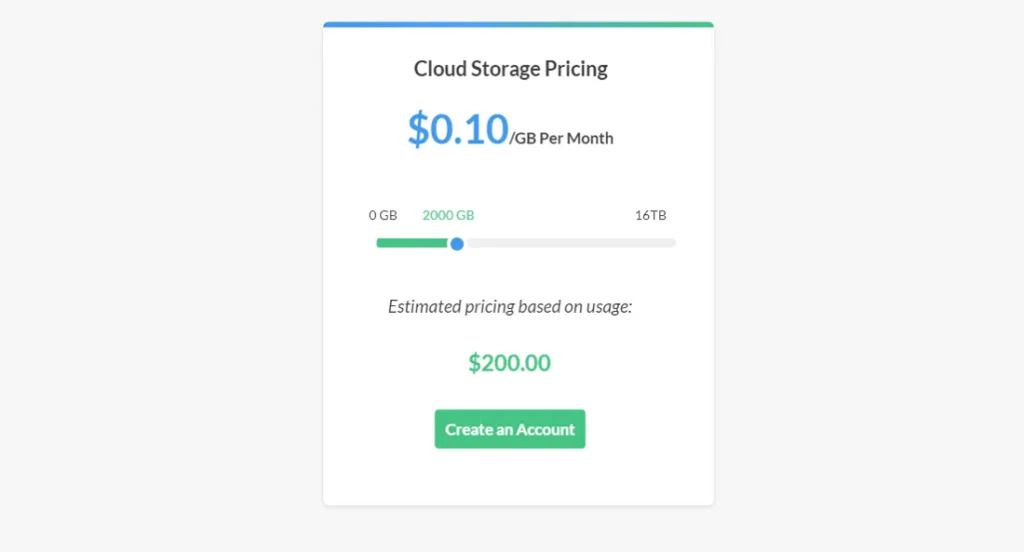
Companies that offer usage-based billing tend to be closer to IaaS than a stereotypical SaaS solution, but there are notable exceptions like email marketing tools and reporting software.
Company that has mastered usage-based billing #1: Digital Ocean
Digital Ocean is a US-based cloud infrastructure provider that offers a variety of services in cloud storage and computing.
Back in 2012, Digital Ocean was one of the first companies to offer SSD-based virtual machines to their clients.
But it wasn’t just the quality of their hosting. How they priced and billed for their service became a key differentiator that helped them establish a core market of software developers and growing software companies.
Let’s examine that in more detail.
Digital Ocean Pricing and Billing Models
Instead of offering static, recurring, monthly subscriptions, the team at Digital Ocean provides their services billed per hour of active use.
So the usage is measured and billed in two separate metrics, the volume of data/bandwidth, and the amount of time that your virtual machines(droplets) are active during the month.
When you examine their pricing page, you can see an advanced and sophisticated approach to metered billing in action.
Droplets and databases can be used and billed on an hourly or monthly basis:
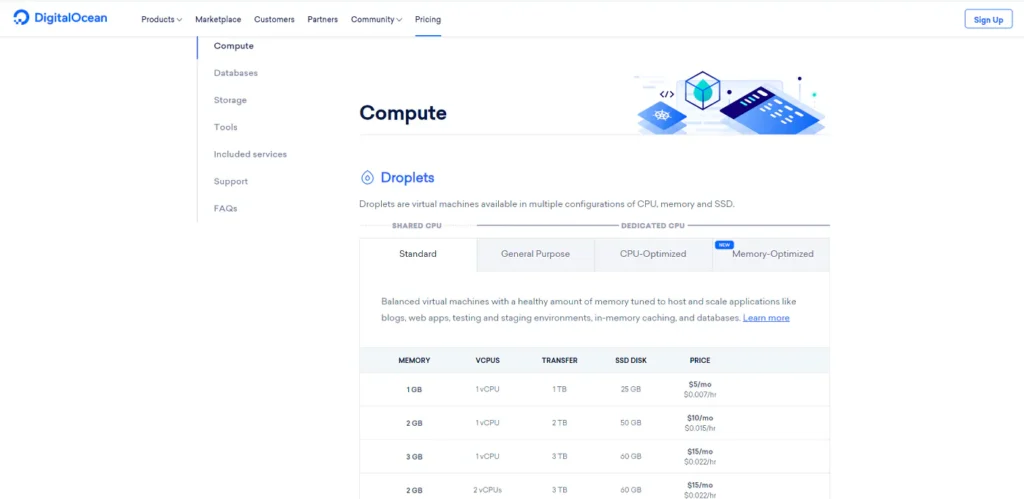
Their smallest droplet with 1GB RAM and 25 GB of SSD storage costs $5 a month, or $0.007 per hour of usage.
Even their add-on tools follow metered billing models, billed per hour of use:
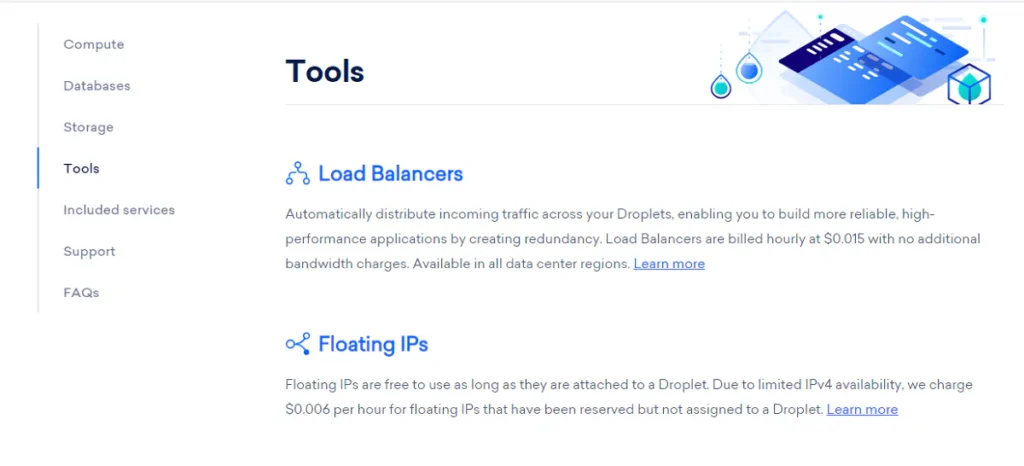
Load balancers are billed at $0.015 per hour, and floating IPs will cost you $0.006 per hour if you haven’t assigned them to a specific droplet.
For customers who only want static storage without any computing, they have developed their Spaces Object Storage product.

Digital Ocean is an example of a subscription product with a mix of fixed-price subscription and metered billing. It has a single, basic subscription plan that applies to all potential customers.
How Metered Billing Differentiates Digital Ocean from Competitors
The founders of Digital Ocean realized early on that the early market for cloud-based hosting (large enterprise companies), was not their target market.
Established competitors had already had years to cozy up to buyers and key decision-makers, and trying to change the status quo would be a long and tedious process.
Instead, they decided to target solo software developers and early-stage software startups that needed a scalable environment.
A 100% metered, usage-based billing model helped Digital Ocean establish itself as a developer-friendly alternative to traditional web hosts. But within the cloud infrastructure industry, many providers were already following usage-based models, on a per-month basis.
By speeding up the implementation process, and making it possible to effectively “rent” virtual machines on an hourly basis, Digital Ocean created a much more cost-effective testing environment for scale tests, staging, and more.
In many ways, it was this billing model that helped them gain a foothold within the developer and startup space, which they still maintain to this day.
As of January, Digital Ocean is the 3rd largest hosting company in the world in terms of the number of web-facing computers.
Company that has mastered usage-based billing #2: Amazon Web Services (AWS)
Amazon Web Services is a mammoth Amazon subsidiary that sells a variety of cloud storage services. True to Bezos form, it started as a way to create a service based on the infrastructure and expertise they gained from setting up a scalable environment for the Amazon ecommerce platform.
Now they offer over 200 separate services in computing, storage, CDN, APIs, and more. AWS does everything within cloud computing.
They followed a metered, pay-as-you-go model since the beginning, when many of their competitors still focused on fixed plans and custom enterprise deals.
This approach helped establish them as a market leader, with a 32.4% market share in 2019.
AWS Pricing and Billing Models
Amazon Web Services was one of the first hosting/storage providers to offer usage-based pricing, and today it stands as an example of some of the most complex tiered metered billing for cloud services.
Amazon S3 storage offers separate price points based on the frequency of access, not just the total size of stored data.
If you need access to the data regularly they have the standard tier, which starts at $0.023 per GB per month.
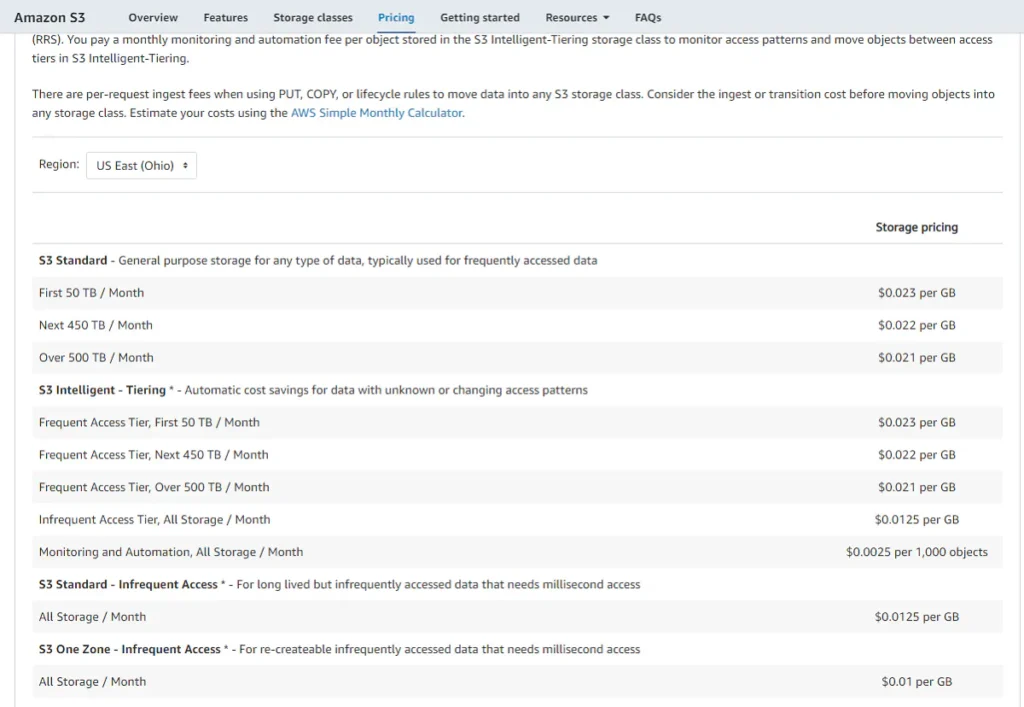
If you don’t need to access the data frequently, you can opt for a pricing tier that costs just over half the price, at $0.0125 per GB.
But here’s the kicker, if you will sometimes need to access the data frequently, and sometimes rarely use it or not at all, you can select the intelligent tier, which prices itself based on your access patterns.
Now that’s sophisticated usage-based billing.
How Metered Billing Differentiates AWS from Competitors
When AWS first hit the market in 2006, Amazon S3 was a cost-effective solution for all forms of cloud storage, without any concerns of complex enterprise contracts, or overpriced services.
With usage-based billing and flexible cloud-based storage/computing, companies could quickly scale their server environments to suit their needs at any given time. They could easily add machines before big promotional events, and reduce the number after the activity went back down.
The billing model, along with with scalability the security, reliability, and Amazon reputation, helped establish them as an early market leader in a burgeoning market, a spot which they still maintain to this day, AWS is still a clear leader in both IaaS and PaaS markets.
But easily scalable systems and usage-based billing has become the industry-wide standard and is no longer a differentiating factor.
But the way it approaches metered billing for S3, with tiers based on access patterns, makes it a natural choice for companies that need to archive files that don’t need to be accessed frequently or companies with irregular usage patterns for stored data.
Company that has mastered usage-based billing #3: Mailgun
Mailgun is a transactional email API service custom-made for developers and software startups that don’t want to create an email solution from scratch.
It makes it easy to send information like booking confirmations and order receipts, as well as integrate powerful user engagement emails throughout your apps/software.
With reliable email validation, easy integrations, advanced analytics, and smart inbound routing, it has established itself as one of the leading email APIs on the market. Billing has also played a role.
Mailgun Pricing and Billing Models
Like most competitors, Mailgun offers tiered fixed price subscriptions based on the overall volume of emails sent, as well as available features.
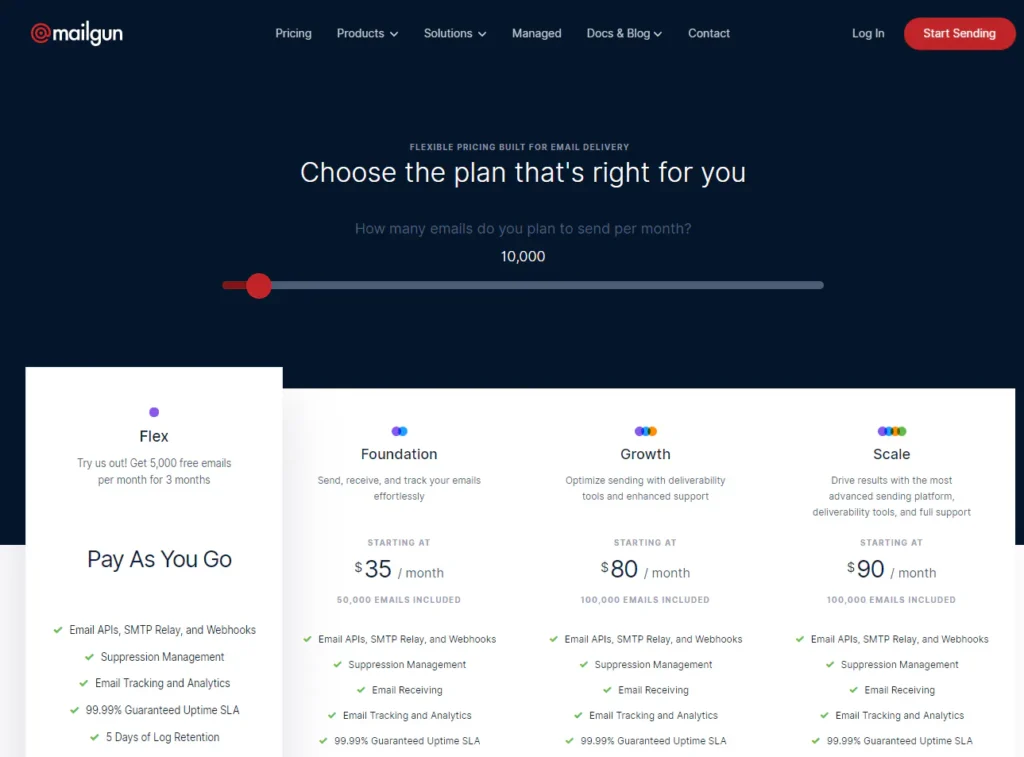
Users can lock in a subscription tier based on how many transactional emails they need to send each month.
But many companies have fluctuating demands for email communication (particularly ecommerce businesses, where seasonality is a major factor in marketing), so committing to a certain number isn’t ideal.
With a purely quantity-based plan, you might have to upgrade and downgrade manually from month to month based on your projected demands.
Instead, Mailgun offers a pay-as-you-go model for any emails you send beyond what’s included in your plan. Usage beyond the scope of the plan follows a metered pricing model, at $0.80 per 1,000 emails.
(Unlike with cloud hosting, instead of 1GB of data, the measured, billable unit is every 1,000 emails sent using the Mailgun API.)
So, for example, a user on the foundation plan will get 50,000 included emails per month. If they send 80,000 emails, they will get billed $24 for the 30,000 emails they send past the 50,000 mark. The total monthly cost will be $59, still significantly cheaper than the next tier level.
Mailgun also offers a limited pay-as-you-go flex plan with limited features that’s viable for early-stage startups and smaller ecommerce stores.
How Metered Billing Differentiates Mailgun from Competitors
Instead of prohibitive enterprise plans, the Mailgun flex plan is very startup-friendly. When the company’s software/service has a small user base, it’s completely free, with three months instead of a 14-day or 30-day time limit, and no commitment to a paid subscription.
Even after the 90 days have passed, the costs are minimal and only grow as their client’s user base and revenue does.
They also offer more predictable monthly plans that are SMB-friendly, since they often prefer regular monthly expenses for easy bookkeeping.
Once a user passes a certain email-threshold or wants more features, they can upgrade to any of the plans at any time.
The combination of fixed price tiers and usage-based pricing allows Mailgun to position themselves for more than one target market.
Company that has mastered usage-based billing #4: MessageBird
MessageBird is an API platform for voice calls, SMS, and WhatsApp, that helps you integrate these channels with other digital customer service channels like email or social.
It offers everything from an online drag-and-drop builder and sender for SMBs, to a robust API with all the integration potential an enterprise needs.
You can use it to send text reminders about invoices, events, and more.
MessageBird Pricing/Billing Models
MessageBird uses a metered billing system with multiple separate billable units, similar to how cell phone carriers handled most plans in the past. (Before the days of unlimited everything).
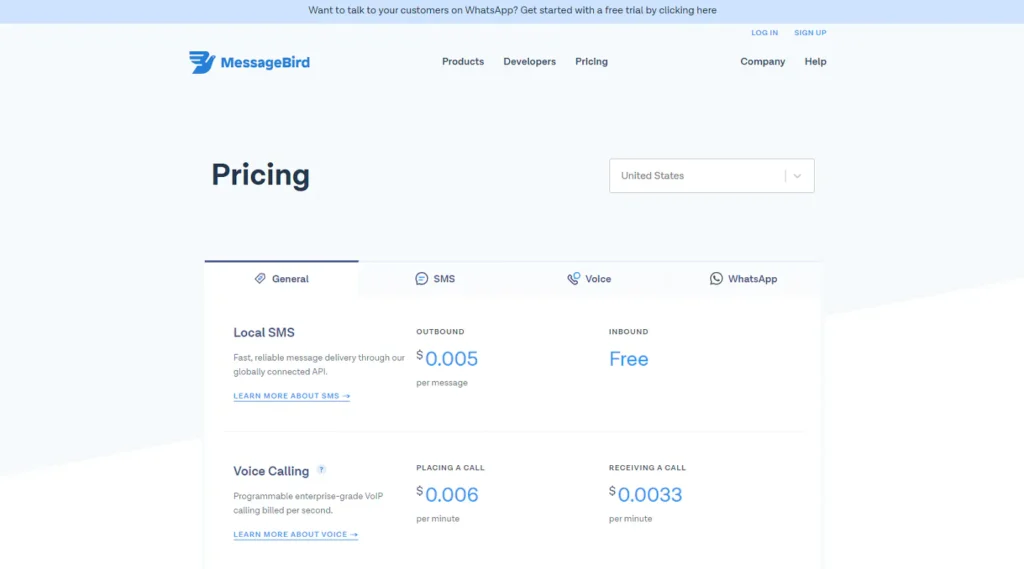
Each local SMS in the US will cost you $0.005, and each minute of outgoing voice calling is $0.006.
Text to speech messages also start at $0.005 per message.
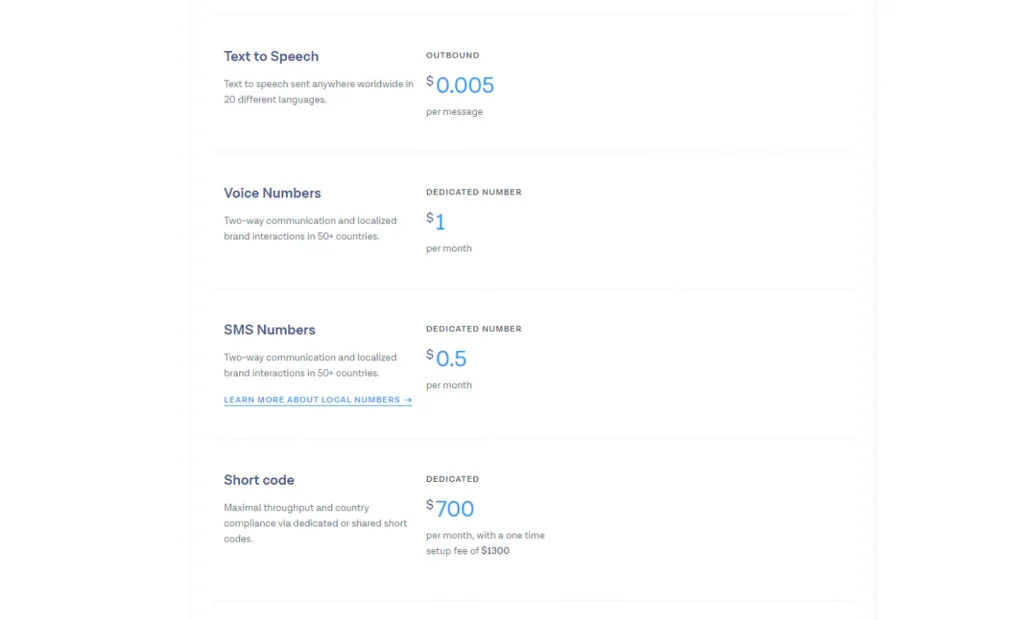
There are also fixed-price addons like voice numbers and SMS numbers. Local, US numbers cost $0.5 per number per month.
A dedicated vanity short code starts at a fixed rate of $700 per month with a one-time fee of $1,300.
There are no monthly or quarterly plans. You simply pay for what you use.

The prices are segmented by country, with SMS messages to Australian numbers coming in at $0.03 — six times more expensive than texts to American numbers.
The fixed-price addons, like dedicated SMS numbers, are also affected by the region. Every Australian one you create will add $10 to your monthly bill, as opposed to $0.5 for US numbers.
How Metered Billing Differentiates MessageBird from Competitors
Since there are no recurring fees, it’s easier for SMBs and early-stage startups to get started with MessageBird.
After all, instead of committing to a sizable monthly payment you can test the solution for less than a cent, and send 200 SMS messages to real customers before it costs a single dollar.
Like with Mailgun, the size of the subscription and bill will organically grow alongside the business of the user.
When an ecommerce store sells more products it will naturally send more reminder texts and other notifications as well.
Company that has mastered usage-based billing #5: WordStream
WordStream is a marketing platform with cross-platform reporting in a single dashboard. It makes it easier for marketers to keep track of their ad spend and performance on Google Ads, Facebook Ads, and other digital advertising platforms.
Its premier offering is somewhere in between a SaaS and a regular marketing consultant retainer.
Their unique approach to usage-based billing might inspire your company.
WordStream Pricing and Billing Models
WordStream has a fairly unique pricing model, where the pricing isn’t directly tied to the access or usage of the product. Instead, the overall ad-spend of the campaigns is what affects the WordStream Advisor price.
WordStream is an example of a quantity-based pricing model with preselected thresholds, rather than a pure metered billing model like we’ve covered in all the other cases.
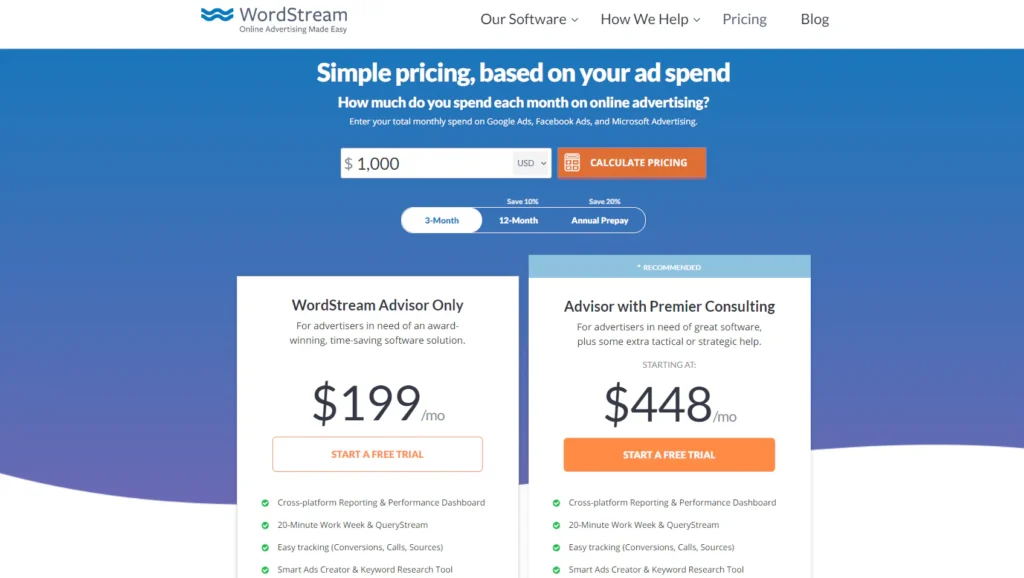
Their subscription plans start at $199 for budgets between and $0 and $1500. Then, there are different fixed-price consulting add ons, like Premier Consulting, which costs $250 extra per month.
| Ad Spend (In dollars) | WordStream Advisor | Advisor + Premier Consulting |
| 0 – 1,500 | $199/month | $448/month |
| 1,501 – 5,000 | $349/month | $598/month |
| 5,001 – 10,000 | $569/month | $818/month |
| 10,000 – 20,000 | $849/month | $1,098/month |
When the ad spend increases, the data processed by the WordStream Advisor will naturally increase alongside it. It is the billable unit that WordStream has singled out because it’s a natural metric of the marketing/agency world.
How Usage-Based Billing Differentiates WordStream from Competitors
Because the costs scale with ad spend, the pricing is more likely to fit the company’s budget and team size.
Instead of limiting the number of reports or creating feature-based plans, the agency/internal marketing team can use the product freely from day one.
The revenue of agencies is usually tied directly to the ad spend they manage, so as the ad spend grows, their spending budget for SaaS solutions will also naturally be larger.
In that sense, it’s as natural as tying transactional email pricing to the number of emails sent.
How To Choose the Best Billing Model for Your SaaS Company?
Is usage-based billing the best option for all SaaS companies and online businesses?
Not necessarily.
To find the best billing model for your company, you can use these three methods:
Competitor Research
Create a list of your leading competitors and go through their pricing and billing models in detail. Are the majority/market leaders relying on fixed subscription billing, usage-based billing, or both?
Interview Existing Customers
Instead of mimicking your competitors, you can see if there is a demand for usage-based billing by asking your customers. Send out a survey to a selection of your user base, or comp them a month in return for a live interview.
Ask them how they feel about your current models/plans, and if they have any ideas for improving them.
A/B Testing
With prospects who visit your website, it’s not a great idea to show them a long survey and ask them what they think. Instead, you can utilize A/B split testing to find out which option is more popular among your prospects.
Test a fixed-price subscription tier pricing page vs. a usage-based page. If the conversion rate for the new billing model is considerably higher, that’s an indicator that you might be missing out.
Whichever model you choose, make sure you price based on value, and that your customers know it, to avoid a cardinal SaaS subscription billing mistake.
How Do B2B SaaS Companies Count Their Customers?
Many early-stage SaaS companies try to keep track of their customers by working with basic payment gateways like Paypal or Stripe, but this can often lead to a lot of manual work in confirming payments and subscriptions or developing custom solutions by using clunky APIs.
With a tailor-made billing solution for B2B SaaS (like Maxio), you get a complete view of not only your existing customers, but advanced monthly recurring revenue breakdowns, historical reports, and more.
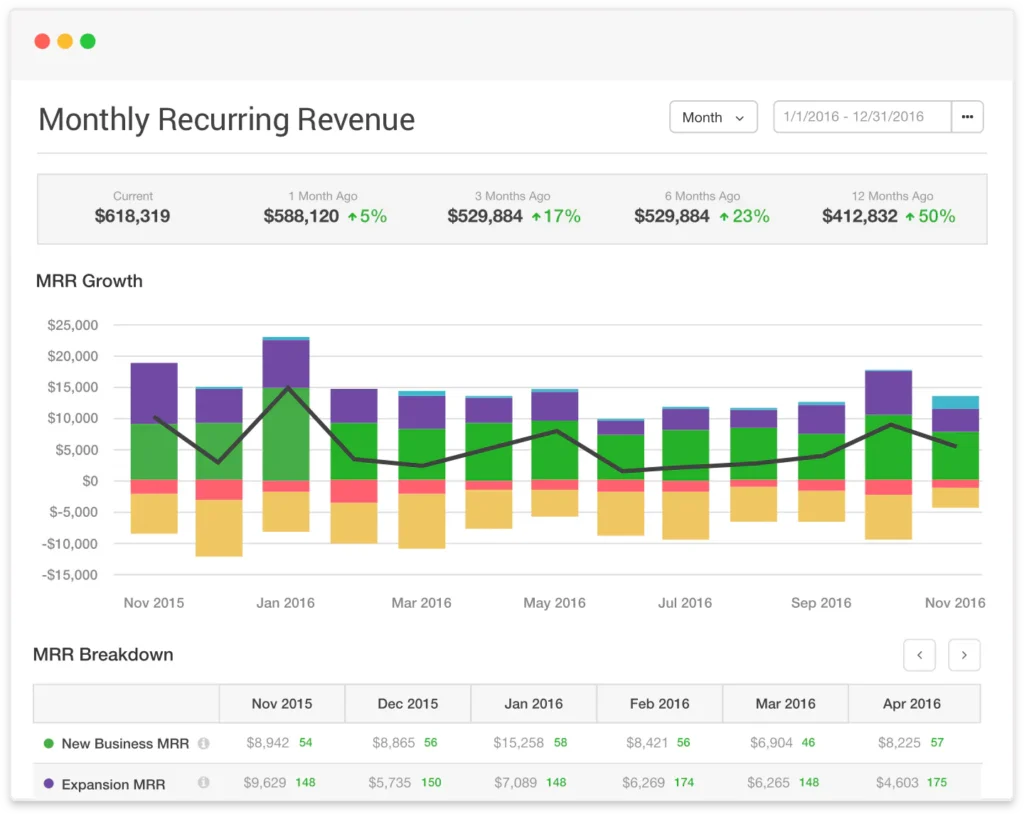
Our smart MRR reports separate new business, expansion, from steady revenue, and factor in churn and other factors like deferred revenue.
You’ll never need to spend hours crunching the numbers in an Excel/Google sheet again.
What Aspects Are Important When Choosing a Billing System?
Choosing billing software for SaaS is a big decision. You must do your due diligence to make sure you choose the right option for your business.
Here are four things that are important to check on when you choose a system:
#1: The system supports your desired billing model
Is your billing model a mix of fixed-price subscription and pay-as-you-go?
Do you have more than one metered billable unit?
The solution you choose must support the complexity of the billing model without issue.
Manually creating custom invoices is not a scalable solution.
#2: The system is easy to Implement
For billing software to be a worthwhile investment, instead of an expense, it needs to be easy to implement on your website.
What to look for:
- Robust API
- Extensive Webhooks/Events
- Great Documentation
#3: The system is built around revenue, retention and dunning
A great billing solution doesn’t just send automatic invoices once every billing cycle. It helps you minimize payment failures, canceled subscriptions, and lost revenue.
With Maxio dunning features, you can easily send trial expiration, credit card expiration, and other reminder emails (complete with merge fields and dynamic content).
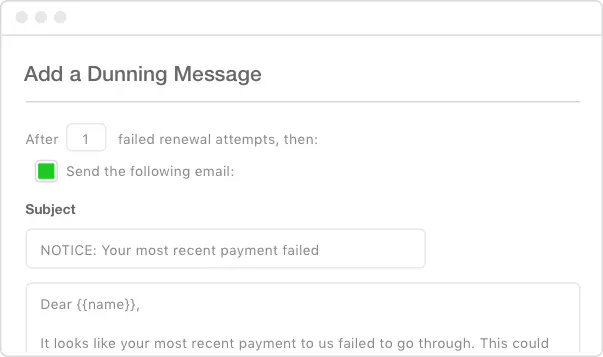
#4: The system is reliable and respected
Before you choose to outsource your billing and payment processing to another company, it’s important that you explore their reputation and make sure they are reliable. Check downtime monitor sites, and read real customer reviews.
For instance, Maxio has over 92% 4 and 5-star reviews on G2 Crowd and overwhelmingly positive feedback on all reliable software review platforms.
Final Thoughts
Billing and revenue management can seem like a bit of a dry topic at first.
But when you realize its power to boost your bottom line and differentiate your company to stand above your competition, it’s easy to get hooked.
That said, replicating the success of the companies we’ve covered is a very difficult task. If you just copy their pricing models, you risk losing existing customers and dropping your existing pricing conversion rates.
As a billing solution for B2B SaaS companies, Maxio has spent the past decade figuring out what works and what doesn’t with pricing and billing optimization.
Over time, we have been able to develop robust solutions that empower any SaaS business to start billing the right way.
With API-support for metered billing, limitless plan segmentation and customization options, personalized offers with automated billing support, in-depth analytics, robust dunning capabilities to minimize avoidable billing-related churn, and a plethora of advanced features, Maxio is the perfect billing partner for your company.
____
If you want to learn how Maxio can help you master metered billing, reach out to one of our SaaS billing experts.


